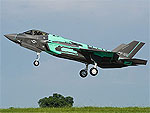Lockheed Martin F-35A Becomes Second Variant To Fly With Mission Systems
 FORT WORTH, Texas, July 7th, 2010 -- The ninth Lockheed Martin [NYSE: LMT] F-35 Lightning II stealth fighter entered flight testing on Tuesday, becoming the second test jet to fly with the next-generation avionics package that will populate all operational F-35s. The F-35A conventional takeoff and landing (CTOL) variant, known as AF-3, flew for 42 minutes during its first flight.
FORT WORTH, Texas, July 7th, 2010 -- The ninth Lockheed Martin [NYSE: LMT] F-35 Lightning II stealth fighter entered flight testing on Tuesday, becoming the second test jet to fly with the next-generation avionics package that will populate all operational F-35s. The F-35A conventional takeoff and landing (CTOL) variant, known as AF-3, flew for 42 minutes during its first flight.
F-35 Test Pilot Bill Gigliotti took off at 6:20 p.m. and initiated a series of flying-qualities tests in a flight focused on propulsion and vehicle systems operation. Some mission systems data were collected before the flight was curtailed by storms in the area.
“AF-3 is very much like the first production F-35s we will deliver to the U.S. Air Force later this year,” said Doug Pearson, Lockheed Martin vice president of F-35 Test and Verification. “AF-3 will be the workhorse for demonstrating the lethal 5th generation combat mission systems capability that will reside in all F-35s.”
The F-35’s avionics, or mission systems, are the most comprehensive and powerful ever to fly in a fighter. The Lightning II gathers, processes and applies data from a wide array of on-board and off-board sensors, enabling the jet to perform command-and-control functions while providing unprecedented situational awareness to the pilot, other air assets and surface forces.
The jet will begin testing with its AESA radar; electronic warfare system; integrated communication, navigation and identification system; inertial navigation system; global positioning system; integrated core processor; and helmet-mounted display system, then integrate other sensors as flight testing progresses. An F-35B short takeoff/vertical landing (STOVL) variant became the first test jet to begin flying the mission systems package on April 7.
Three F-35 variants are under development – the F-35A CTOL variant to replace U.S. Air Force F-16s and A-10s, as well as aircraft employed by seven allied nations; the F-35B STOVL variant to replace U.S. Marine Corps AV-8B Harriers and F/A-18s, U.K. Royal Air Force and Royal Navy Harrier GR.7s, GR.9s and Sea Harriers, and Italian Harriers; and the F-35C carrier variant to replace U.S. Navy F/A-18s.
The F-35 Lightning II is a 5th generation fighter, combining advanced stealth with fighter speed and agility, fully fused sensor information, network-enabled operations, advanced sustainment, and lower operational and support costs. Lockheed Martin is developing the F-35 with its principal industrial partners, Northrop Grumman and BAE Systems.
The F-35 program has about 900 suppliers in 45 states, and directly and indirectly employs more than 127,000 people. Thousands more are employed in the F-35 partner countries, which have invested more than $4 billion in the project. Those countries are the United Kingdom, Italy, the Netherlands, Turkey, Canada, Australia, Denmark and Norway.